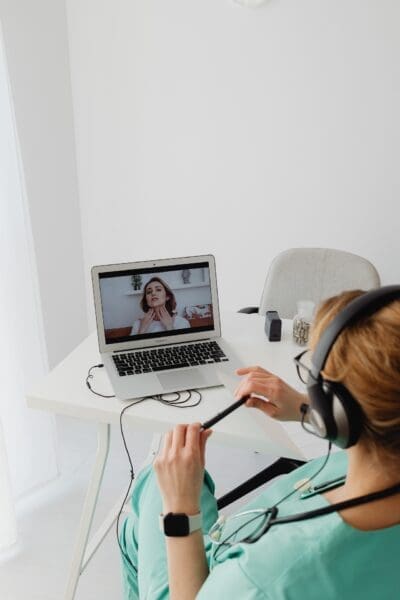Exploring the Benefits of Telemedicine Kiosks

Kiosks help reduce employees’ time to take work off to visit their doctor. They also minimize patient frustration with lengthy check-in times.
These kiosks can be reimagined as “Health Pods” that provide a private space for consultation and a range of devices performing point-of-care clinical measurements (such as blood pressure monitors, thermometers, and stethoscopes). Health Pods can also connect patients via direct Internet video communication with practitioners.
Patient Self-Diagnosis and Self-Care
Telemedicine is an excellent way to avoid time-consuming and costly hospital visits for medical consultations. With telemedicine, patients can have instant access to doctors to resolve their health issues, save on time spent at hospitals, and avoid additional traveling expenses, such as fuel costs, transportation fees, and parking charges.
Moreover, a telemedicine kiosk allows employees to stay at work instead of going to hospitals and doctors’ clinics to seek medical assistance. This significantly reduces the amount of lost productivity that accompanies frequent hospital visits.
In addition, many telemedicine kiosks are equipped with diagnostic sensors to assess symptoms such as headaches, aches and pains, or dizziness. Kiosks can also assist patients with completing necessary forms, such as submitting medical history or insurance information, that would otherwise take up physicians’ valuable time during appointments.
Micheal Sharp, communications director at TelaCare, which manufactures telemedicine kiosks, said they are seeing an uptick in demand for the devices during the COVID-19 pandemic. From wall-mounted stations in private cabins to soundproof structures with enough equipment inside to make a doctor on the Starship Enterprise jealous, these kiosks are popping up in shopping malls, office buildings, and pharmacies across America.
Increasing Job Satisfaction
A kiosk technology allows healthcare professionals to assess and diagnose patients remotely. Using the latest video conferencing capabilities, a doctor can examine the patient and prescribe or advise on treating specific illnesses.
During the COVID-19 pandemic, telemedicine became more prevalent, and several healthcare providers started to use telehealth kiosks to boost patient engagement and reach a wider audience. Kiosks are typically used in the same conditions that make people visit a doctor, such as a sore throat, cough, and earache. The kiosks allow patients to avoid the long lines and expensive transportation costs of visiting a doctor or hospital, and can be done in their homes.
As healthcare providers face a labor shortage, using health kiosks is helping alleviate some of their problems by allowing patients to check themselves in independently without waiting for an appointment. In addition, it will enable healthcare workers to focus on more high-value tasks and can help manage a limited number of resources, such as medical equipment and personnel. Patients can also save on travel expenses and avoid the risks of coming in contact with other sick patients, especially those who are immune-compromised. They can access a virtual consultation with their doctors from a kiosk at a local mall or other strategic locations.
Reduced Need for Hospital Beds
With telemedicine kiosks, medical staff no longer have to wait to check in patients. Instead, they can use self-serving kiosks to fill out necessary forms and print instructions for their next appointment. This helps save medical staff time, protects them from infection, and allows them to spend more time on the frontlines of healthcare.
The technology behind telemedicine has undergone an incredible transformation in recent years. The new healthcare models that it has enabled are proving to be game-changing, especially during a pandemic.
Remote medical consultation is a great way to help people who live far from specialists and reduce patients’ time in waiting rooms or clinics. It can also save money, help prevent over-treatment, and help avoid unnecessary hospitalizations.
The CDC has urged hospitals to use telemedicine to protect patients and keep operations running smoothly. We are seeing the benefits of telehealth in various settings, from specialist clinics to the ED. In some cases, even primary care is embracing the concept of distributed healthcare.
One example was used by several hospitals during the COVID-19 pandemic to quickly screen patients and identify those with suspected symptoms of the virus. It is a simple but effective solution that reduces nurses’ workload, allowing them to focus on more urgent cases.
Increasing Consumer Focus
Before the COVID-19 pandemic, utilization of telemedicine was low in the U.S. In part, this was due to uncertainty about coverage for telemedicine services by employers’ health plans and state insurance regulators. Additionally, implementing telemedicine requires significant capital investment and complex workflow reconfigurations to accommodate the specialized needs of patients and health providers.
Health kiosks, or “health pods,” can offer private spaces for consultations along with a range of devices performing point-of-care clinical measurements (e.g., blood pressure monitors, oximeters, and stethoscopes). Combined with the video chat component, this creates a one-to-one interaction between the patient and physician. This helps to reduce the number of times a patient must visit an office or clinic and also cuts down on the risk of transmission of infectious diseases between patients and staff members.
Telemedicine kiosks help to make medical care more accessible to remote and underserved populations. For example, a company that produces telemedicine kiosks has been deployed during the pandemic to screen patients for possible cases of COVID-19, substantially shortening nurses’ intake time and protecting them from infection.
Other vendors are also deploying telemedicine kiosks in places where healthcare is hard to come by.









